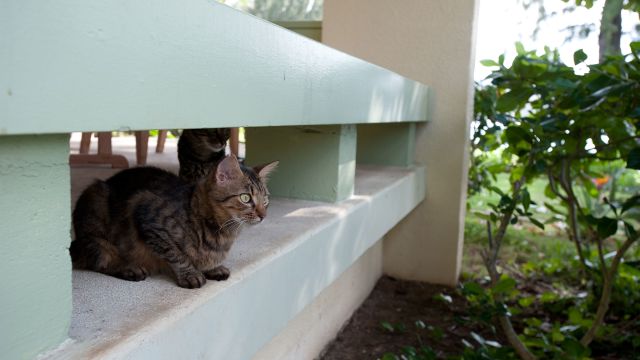It’s hard to go anywhere in Hawaii without running into at least one free-roaming cat. These include feral cats, pets allowed to roam, and lost and abandoned animals. Cats are everywhere—in large feral colonies, roving through neighborhoods and in private residences. Whether you love them or consider them a nuisance, cats are omnipresent. It’s important to understand how they could affect your health.
Free-roaming cats pose unique health and conservation concerns. They are considered an invasive species that will hunt and kill native species, including endangered birds such as the Palila and Uau, according to the Hawaii Invasive Species Council. Cats may also carry the parasite, Toxoplasma gondii, which is a threat to the Hawaiian monk seal and native birds such as the Alala and Nene. Exposure to this single-celled parasite can also be dangerous for some people, especially pregnant women.
There is no simple solution for this public health threat. Feral cats are the same species as the common house cat that people have kept as pets for millennia. Eliminating them in large numbers is a poor response that many animal lovers oppose. Being aware of the risks associated with cat-related illnesses and learning how you can help free-roaming cats in your community can help you protect yourself and your family.
Toxoplasmosis: A parasite with a unique lifecycle
One of the best-known infections associated with cats is toxoplasmosis. This is a parasitic infection that relies on felines, including cats, to reproduce. The parasite can only reproduce in the gut of an infected cat. Once the parasite reproduces, cats will shed huge numbers of oocysts (think of them as parasite eggs) for one to three weeks in their feces. The oocysts can then enter soil and waterways. “We're talking about millions of eggs [oocysts],” explains Michelle Barbieri, DVM, MS, Wildlife Veterinary Officer for NOAA Pacific Islands Fisheries Science Center. She continues, “those eggs [oocysts] live in the environment for a really long period of time, many months, up to a couple years or so. Then, even though the cat is no longer excreting those eggs [oocysts] in its feces, they're still in the environment.”
Once T. gondii oocysts are in the environment, the parasite can infect intermediate carriers such as rodents or birds. Larger animals that are raised for human consumption, like pigs, can also become infected. The parasite affects brain and muscle tissues of these intermediate carriers. Rodents with toxoplasmosis will often lose their fear of cats making them easier prey. Cats that consume one of these intermediate carriers will then become infected with the parasite. They can also become infected by exposure to oocysts in their environment by drinking contaminated water or cleaning themselves after playing in dirt where oocysts are present.
People can get toxoplasmosis in the following ways:
- Eating undercooked meat from an infected animal (such as infected pork)
- Handling infected cat feces
- Gardening in areas where cat feces are or have been present, and not thoroughly washing hands before eating
- Drinking water or eating food that may be contaminated by cat feces
Keep in mind, some form of contact or ingestion is required to become infected with toxoplasmosis. As Sarah Park, MD, head of the Hawaii Department of Health’s Disease Outbreak Control Division explains, “if the average person is walking by a feral cat or is some distance from a feral cat, they're not going to be at risk.”
What does toxoplasmosis do to people?
For the average, healthy person, toxoplasmosis won’t cause any serious problems. “Our immune system deals with it and it's never usually a problem,” says Dr. Park. “At most, when you get infected, you might have some fever and feel unwell for a while, but it's not really a problem or a concern.” Many people have had toxoplasmosis at some point without realizing it, she points out.
Although toxoplasmosis is often nothing to worry about, sometimes people with healthy immune systems can suffer from eye damage due to ocular toxoplasmosis. Symptoms include pain, red eyes, decreased or blurred vision and possible tearing. An ophthalmologist can diagnose ocular toxoplasmosis and determine the correct course of treatment.
Aside from rare ocular infections, toxoplasmosis can have devastating effects for those with compromised immune systems and pregnant women. Pregnant women themselves aren’t at risk, but their unborn fetuses can suffer major neurological problems, developmental delays, blindness and even death.
Toxoplasmosis is treatable, but treatment often won’t completely kill the parasite. In most cases, only pregnant women, infants and those with compromised immune systems require treatment as healthy people tend to recover without it.
Toxoplasmosis is a danger to wildlife, too
Hawaiian monk seals are beloved members of the local wildlife. Their numbers are currently relatively stable at around 1,400 animals spread throughout the Hawaiian Island chain, including the Northwestern Hawaiian Islands, thanks to direct conservation efforts. Toxoplasmosis is lethal to this endangered species, which is already under pressure from climate change, lack of prey and pollution, particularly ocean trash.
“We are certain that we have had at least 11 monk seals die from toxoplasmosis. And that is a very conservative number,” says Dr. Barbieri. That’s about 0.8 percent of the entire population. Since monk seals are wild animals, it’s impossible to know exactly how many become infected and die from toxoplasmosis since it could happen at sea and their bodies may never wash up on shore. The true number could be far higher.
“The risk to monk seals is much bigger than just a cat being on the beach,” says Barbieri. “It is the risk of that pathogen being flushed from anywhere land to sea, and we probably have that happening pretty much circumferentially around the islands.”
Cat scratch disease is also a problem
Cat scratch disease (CSD) is another infection linked with free-roaming cats, particularly kittens, Park cautions. Cats may carry fleas that are infected with a type of bacteria, called Bartonella henselae. People, especially kids under 15 years old, who handle cats with fleas that carry the Bartonella bacteria can become infected. The germs can spread when an infected cat bites or scratches a person breaking their skin or if it licks a scab or open wound.
Symptoms of cat scratch disease include:
- Low-grade fever
- Papule (lump) or pustule (pimple) at infection site
- Tender, sore lymph nodes one to three weeks after exposure
Like toxoplasmosis, most cases of CSD in healthy people will resolve on their own without treatment. As Park says, “you can use antibiotics, but it may not go away immediately.” Rarely, complications may arise from CSD in young children and those with a weakened immune system.
Preventing the spread of cat-related illness
By far, the best way of preventing cat-related diseases is to keep cats indoors. “Keeping cats indoors is better for wildlife, humans and the cats themselves,” says Barbieri. Indoor cats are less likely to be exposed to toxoplasmosis or get fleas that carry Bartonella. They also live longer than outdoor cats.
Anyone who is pregnant or at risk for toxoplasmosis due to a weakened immune system should avoid cleaning litter boxes or handling cat feces in any way. Additionally, gardening in areas where cats are or may have been present increases the risk for the infection. Be sure to fully cook meat before eating and wash any products or utensils such as counters or cutting boards that have come in contact with raw meat with warm, soapy water. Wear gloves and thoroughly wash your hands with soap and water for at least 20 seconds after gardening or handling raw meat to prevent exposure to T. gondii. Do not pet or handle unfamiliar stray cats. This is particularly important for children who are more susceptible to CSD.
Unfortunately, feral cats usually can’t be adopted, and there are simply too many of them to expect to find homes for all of them. To help reduce their numbers, there are several low-cost Trap-Neuter-Release-Monitor (TNRM) programs available. The Hawaiian Humane Society, HI CatFriends and Hawaii Cat Foundation all provide TNRM services. On Oahu alone, an estimated 6,000 cats are sterilized each year. Any cat with a notched ear has been spayed or neutered. Those numbers are promising, but so far, that’s not enough to significantly curb the homeless cat population. In order to drastically reduce their population, “you pretty much have to spay and neuter 80 to 90 percent of the cats that are available,” says Barbieri.
If you are interested in helping the feral cat population, consider volunteering at a local animal or cat advocacy group, or donating to one of these organizations. Some of these groups include the Hawaiian Humane Society, the Oahu SPCA, the Maui Humane Society, the Hawaii Island Humane Society, the Kauai Humane Society, the Lanai Cat Sanctuary, HI CatFriends and the Hawaii Cat Foundation.






